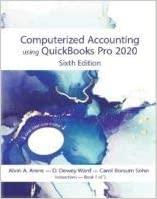Question
You are a financial analyst for a mutual fund and need to determine the value of the stock of VentureFund Inc. VentureFund Inc. is a
You are a financial analyst for a mutual fund and need to determine the value of the stock of VentureFund Inc. VentureFund Inc. is a new and growing corporation.
The following table describes the characteristics of VentureFund Inc.:
| Stock | Covariance of stock with the market | Annual EPS Forecast (for Year 1) |
| NewEquity Inc. | 0.03 | $3.00 |
| Year 1 | Year 2 | Year 3 and onwards | |
| Payout ratio | 25% | 50% | 75% |
| ROE | 20% | 10% | 20% |
| EPS | $3 | ? | ? |
| Expected Price | $100 | $100 | ? |
Note: the growth rate calculated in any given year applies to next years earnings per share (EPS). For example, the EPS in year 1=EPS in Year 0* (1+growth rate in Year 0).
After Year 3, the payout ratio and return on equity (ROE) will remain constant forever at 75% p.a. and 20% p.a, respectively. The expected stock market risk premium is 5% p.a., the risk-free rate is 3% p.a, and the market standard deviation is 15% p.a. Assume that all rates given are compounded annually.
(a). Using the CAPM, what is the required rate of return for the stock of Venture Fund Inc.?
(b). Assuming that the CAPM is correct, what should the price of Venture Fund Incs stock be today?
(c). Suppose the expected stock price in Year 2 is $100. What is the PVGO of VentureFund Inc.s stock at the end of Year 2 (note that the dividend in Year 2 has already been paid out)?
(d). Suppose you read the Wall Street Journal and learn that there is a lot of competition in VentureFund Incs industry and the ROE of the company is expected to go down to the required rate of return starting in Year 3. What is the present value of VentureFund Inc. at Year 2 (note that the dividend in Year 2 has already been paid out)?
(e). Assume that your calculation in part (d) is the forecasted price for VentureFund Inc. at the start of Year 3. Describe a 1-period short selling strategy, between Year 2 to Year 3, in which you can profit from this situation, assuming no market imperfections. What would be your 1-period profit (in $) if you followed this strategy? (Ignore any dividend payments that might occur).
(f). If the market is (i) weak-form, (ii) semi-strong form, or (iii)strong form efficient, can you profit from the information that you learned in part (d)? Explain.
Step by Step Solution
There are 3 Steps involved in it
Step: 1

Get Instant Access to Expert-Tailored Solutions
See step-by-step solutions with expert insights and AI powered tools for academic success
Step: 2

Step: 3

Ace Your Homework with AI
Get the answers you need in no time with our AI-driven, step-by-step assistance
Get Started


